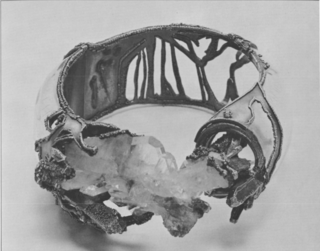
The World's Columbian Exposition was a world's fair held in Chicago in 1893 to celebrate the 400th anniversary of Christopher Columbus's arrival in the New World in 1492. The centerpiece of the Fair, held in Jackson Park, was a large water pool representing the voyage Columbus took to the New World. Chicago had won the right to host the fair over several other cities, including New York City, Washington, D.C., and St. Louis. The exposition was an influential social and cultural event and had a profound effect on American architecture, the arts, American industrial optimism, and Chicago's image.

Art Nouveau is an international style of art, architecture, and applied art, especially the decorative arts. The style is known by different names in different languages: Jugendstil in German, Stile Liberty in Italian, Modernisme in Catalan, and also known as the Modern Style in English. It was popular between 1890 and 1910 during the Belle Époque period, and was a reaction against the academic art, eclecticism and historicism of 19th century architecture and decoration. It was often inspired by natural forms such as the sinuous curves of plants and flowers. Other characteristics of Art Nouveau were a sense of dynamism and movement, often given by asymmetry or whiplash lines, and the use of modern materials, particularly iron, glass, ceramics and later concrete, to create unusual forms and larger open spaces.

A blacksmith is a metalsmith who creates objects primarily from wrought iron or steel, but sometimes from other metals, by forging the metal, using tools to hammer, bend, and cut. Blacksmiths produce objects such as gates, grilles, railings, light fixtures, furniture, sculpture, tools, agricultural implements, decorative and religious items, cooking utensils, and weapons. There was an historical distinction between the heavy work of the blacksmith and the more delicate operation of a whitesmith, who usually worked in gold, silver, pewter, or the finishing steps of fine steel. The place where a blacksmith works is called variously a smithy, a forge or a blacksmith's shop.

Robert Koehler was a German-born painter and art teacher who spent most of his career in the United States.

Pabst Blue Ribbon, formerly known as Pabst Beer and commonly abbreviated PBR, is an American lager beer sold by Pabst Brewing Company, established in Milwaukee, Wisconsin, in 1844 and currently based in San Antonio. Originally called Best Select, and then Pabst Select, the current name comes from the blue ribbons tied around the bottle neck between 1882 and 1916.

Philip Simmons was an American artisan and blacksmith specializing in the craft of ironwork. Simmons spent 78 years as a blacksmith, focusing on decorative iron work. When he began his career, blacksmiths in Charleston made practical, everyday household objects, such as horseshoes. By the time he retired 77 years later, the craft was considered an art form rather than a practical profession.
Francis Whitaker was a blacksmith in Carmel-by-the-Sea, California, where he established The Forge in the Forest. He had The Mountain Forge, in Aspen, Colorado, which he later relocated when he was named an artist-in-residence at the Colorado Rocky Mountain School in Carbondale, Colorado.

Ironwork is any weapon, artwork, utensil, or architectural feature made of iron, especially one used for decoration. There are two main types of ironwork: wrought iron and cast iron. While the use of iron dates as far back as 4000BC, it was the Hittites who first knew how to extract it and develop weapons. Use of iron was mainly utilitarian until the Middle Ages; it became widely used for decoration in the period between the 16th and 19th century.

Carl von Marr was an American-born German painter whose work encompassed religious and mythological subjects, genre, and portraits. He was also a professor of art in Munich.

Jean Tijou was a French Huguenot ironworker. He is known solely through his work in England, where he worked on several of the key English Baroque buildings. Very little is known of his biography. He arrived in England in c. 1689 and enjoyed the patronage of William III and Mary II where he was titled as England's Best Wrought-iron Designer. He was employed at St Paul's for twenty years. Not only did he work for royal destinations, but he also worked for estates and other private homes located on the countryside. He left England for the continent c. 1712. He was father-in-law to the painter of decorative schemes Louis Laguerre who married in St Martin-in-the-Fields in London. Tijou had a wife named Ann Tijou as well as a daughter. She was married in the church of St. Martin's. Both wife and daughter were buried there as well.

Gaetano Trentanove was an Italian and American sculptor.

Villa Terrace is a historic house in Milwaukee, Wisconsin. It was built in 1924 for the Lloyd R. Smith family - an Italian Renaissance-style home on a bluff above Lake Michigan. Since 1966 the house and grounds have housed the Villa Terrace Decorative Arts Museum. It is listed on the National Register of Historic Places as Lloyd R. Smith House.
John Rais is a designer, blacksmith and sculptor known for his architectural work, vessels, and furniture. Rais primarily works in steel as well as titanium, bronze, copper, stainless steel, and other materials. He is well known for his one-of-a-kind firescreens. Rais was born and raised in Burlington, Massachusetts, the youngest of seven children. Rais was introduced to blacksmithing in a sculpture class at the age of 18. He went to college at the Massachusetts College of Art, graduating in 1995, BFA Sculpture. After working at an architectural ironworks and a living history museum in Massachusetts, he decided to go to graduate school. Rais received his masters of fine arts degree from Cranbrook Academy of Art in 1998, after which he worked at Peters Valley Craft Center as a department head. Rais was a department head of blacksmithing at Peter's Valley from 1998 to 2001. He has run his own design and metalsmithing studio since 1998. He now resides in Philadelphia, PA.
L. Brent Kington was an art educator and visual artist who worked in blacksmithing and sculpture. Kington was a product of the studio craft movement in jewelry and hollowware. In 1969 he served as the first president of the Society of North American Goldsmiths. He is frequently hailed as the man responsible for the blacksmithing revival which took place in the late 1960s and early 1970s.

Fred Fenster is a metalsmith and professor emeritus of the University of Wisconsin at Madison where he taught art and education. He is particularly known for his work in pewter, influencing generations of metalsmiths. Fenster was named a Fellow of the American Craft Council in 1995.
Gary Lee Noffke is an American artist and metalsmith. Known for versatility and originality, he is a blacksmith, coppersmith, silversmith, goldsmith, and toolmaker. He has produced gold and silver hollowware, cutlery, jewelry, and forged steelware. Noffke is noted for his technical versatility, his pioneering research into hot forging, the introduction of new alloys, and his ability to both build on and challenge traditional techniques. He has been called the metalsmith's metalsmith, a pacesetter, and a maverick. He is also an educator who has mentored an entire generation of metalsmiths. He has received numerous awards and honors. He has exhibited internationally, and his work is represented in collections around the world.
Klaus Rudolf Werhand was a metalsmith and a coppersmith from Neuwied, Rhineland-Palatinate, Germany.
Aloys Loeher (1850–1904) was an American sculptor. He created a signature piece which was exhibited at the 1893 Columbian Exposition. Among his other works are the Siegfried Monument in New York, the Fritz Reuter Monument in Chicago, and a number of medals and busts.

Eleanor Moty, is an American metalsmith and jewelry artist. Her experimentation with industrial processes, such as photoetching and electroforming, was revolutionary in the field of American art jewelry in the 1960s and 1970s.
Myra Mimlitsch-Gray is an American metalsmith, artist, critic, and educator living and working in Stone Ridge, New York. Mimlitsch-Gray's work has been shown nationally at such venues as the John Michael Kohler Arts Center, Museum of the City of New York, Metropolitan Museum of Art, Cooper-Hewitt Smithsonian Design Museum, and Museum of Arts and Design. Her work has shown internationally at such venues as the Middlesbrough Institute of Modern Art, Stadtisches Museum Gottingen, and the Victoria and Albert Museum, and is held in public and private collections in the U.S, Europe, and Asia.




















